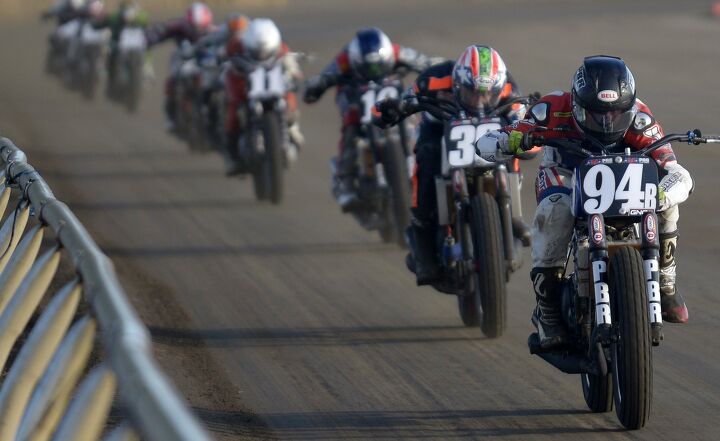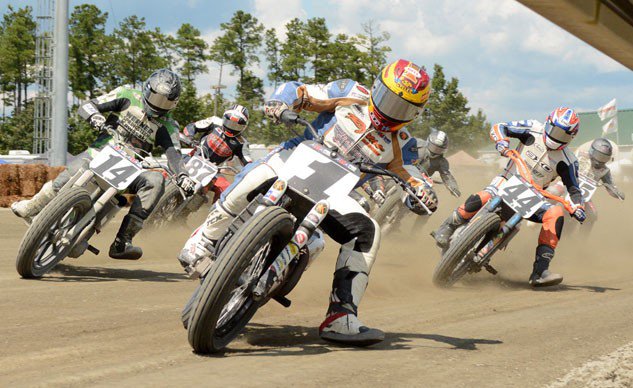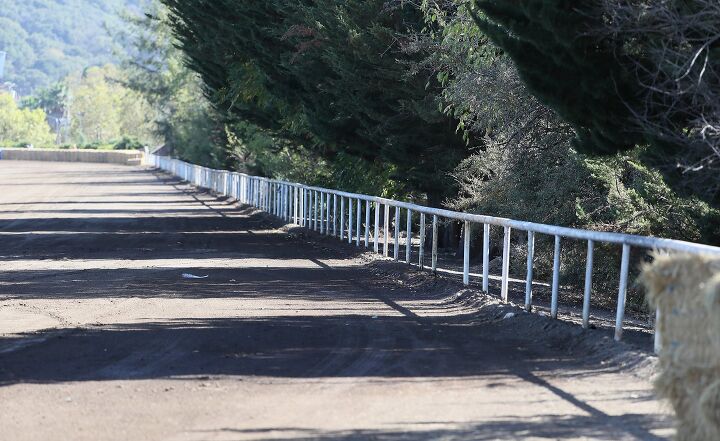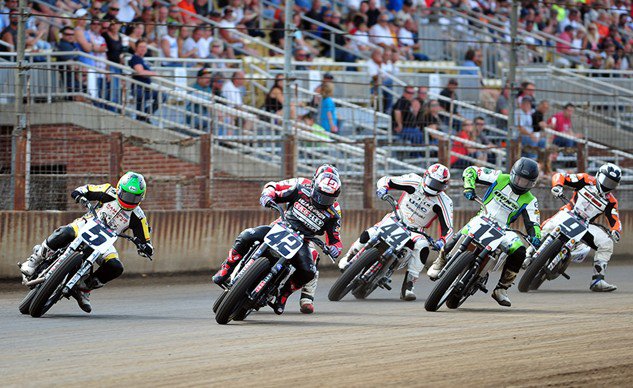
 |
|
|
#1 |
|
All the news that's fit to excerpt
Name: newsie
Location: who knows?
Join Date: Jun 2008 Motorcycle(s): only digital replicas Posts: Too much.
|
[motorcycle.com] - American Flat Track Safety: Interviews With Michael Lock And Chris
 A month ago, we published an interview with AMA Pro Racing CEO Michael Lock about the future of the American Flat Track Series. While the topics covered were wide-ranging, we felt that, given the two fatalities at the season-closing event at Santa Rosa, the section on the seriesí safety should be broken out into its own section. Ironically, neither of the Santa Rosa incidents involved the elephant in the flat track room: the barriers at the edge of the track. Still, when the immediate reaction is to think of the barriers, namely the horse rails at the edge of many tracks, upon learning of a major incident at a flat-track race, the series has a safety problem that warrants a serious look. American Flat Track Series: Interview With AMA Pro Racing CEO Michael Lock Pro Flat Track Racer Charlotte Kainz Dies In Santa Rosa Crash Fortunately, the two American Flat Track representatives we talked to are looking seriously at how these issues can be resolved. While no quick fix is immediately available, both Michael Lock and Chief Competition Officer, Chris Carr (who most readers will know for his seven Grand National Championships), say that change is in the works for the series. MO: Youíve also said that youíre planning on trying to move the events closer to metropolitan areas to entice people who may not have experienced flat track racing before. That seems to make a lot of sense. My question is that youíve specifically mentioned horse tracks. Those havenít been typically set up for motorsports the way motorsports-specific facilities are. How are you planning to address the concerns about safety?  Close racing and the ever-present railing are two of the hallmarks of flat track racing. Close racing and the ever-present railing are two of the hallmarks of flat track racing.ML: For sure, safety is an issue, but our two most successful Ė long-term successful Ė mile tracks are the Sacramento Mile and Springfield. They are horse tracks. So, itís not inherently whether itís a horse track or not thatís the issue. Itís the specifics of it. Weíre looking now at venues for the future, and Iím sending Chris Carr and Steve Morehead, who are our two most experienced technical guys, as an advanced party to do an analysis for any potential venue and to do a technical report and say either itís great or itís impossible or with these modifications and this addition that we could go there. One of the things we changed between 2015 and 2017, and experimented with in 2016, is a more comprehensive deployment of Air Fence. Traditionally, weíve been running more Air Fence on miles the half-miles, but weíve been running somewhere in the region of about 50 to 52 pieces through corners 1 to 4. What we did was we progressively stepped that up during the year, and weíre up to about 64 pieces that we deploy on some miles, particularly Springfield, which has got long, continuous corners. Itís almost impossible to see where the corner starts and ends. Weíve been building up the Air Fence deployment, which means that you push further and further away from the apexes, the hay bales. The hay bales are much more effective when theyíre not on the apex of the corner where the Air Fence is much more effective. MO: I know that the angle of impact is important for Air Fences. They are better at direct impacts than glancing blows. Iíve been told that sections have been developed that can handle the oblique impacts better. ML: There is an Air Fence that we have had a look at. Iím going to be asking my team to evaluate over the rest of this off season. Itís not an deflatable fence. The Air Fence that we deploy at the moment, all these pieces, are filled with air and then deflated for travel. There is a second type that is basically permanently inflated, which weíre looking at for potential future deployments. The issue of it is a logistics one. If they donít deflate, man, you need a big truck. Or you need a bunch of trucks. Weíre looking at how we could make that happen. Certainly, thatís an innovation for the future that weíre taking seriously.  Racing at the Sacramento Mile. Photo courtesy American Flat Track Racing at the Sacramento Mile. Photo courtesy American Flat TrackMO: In these horse tracks youíve got these epic photos of the guys in a freight train right up against the rail with the field trailing into the background, but attached to the other side of the rail are these exposed posts. Do you have any plans for addressing that. Is that going to limit your new tracks? ML: I donít think so. I think thereís always a solution we can plan in for that, whether it be some kind of board you put in front or whether you use some of these sleeper installations they use in highway repair. So, weíve got a number of things weíre looking at. Because safety is ever-evolving. You never get to 100%. You just keep trying to raise the bar. MO: For me, since I come from the roadracing side, seeing riders in close proximity to the barriers is difficult to wrap my head around. I know that we donít want to have things like what happened at Santa Rosa, which was terrible. One seems like it was just a freak racing accident where a bike got airborne, but the other one, I believe, he collided with a post.* ML: No, he collided with the ground. MO: It was not a post at the edge of the track? ML: Yeah, he came off the bike and hit the ground fairly hard. I donít know that there was anything we couldíve done proactively. Obviously, that is something that weíve been looking at. MO: I had friends that were there when it happened, and they said they thought he hit the post. ML: I think he hit the ground first, but either way, the bike certainly hit the post and took the post out. MO: So, thatís probably where the perspective I was given came from.* ML: Weíve obviously reflected long and hard on Santa Rosa. Itís not the kind of thing you ever want to happen. One of the first calls I got was from Wayne Rainey because they had a double accident at Laguna Seca the year before. And itís devastating when this happens. The first thing that you do is you go back through all your processes and say, ďOkay, with the benefit of seeing whatís happened, what could we have done differently?Ē You do that all the time.  The horse railing at the edge of many tracks presents the biggest safety concern. Photo by Brian J. Nelson The horse railing at the edge of many tracks presents the biggest safety concern. Photo by Brian J. NelsonA Brief Interview with American Flat Track Chief Competition Officer Chris Carr Although Michael Lock was quite forthcoming with his information concerning the safety of riders in American Flat Track, we thought it would be good to hear from a life-long flat-track racer who now has the formidable task of helping to make the sport safer while continuing to grow the series. So, we got him on the phone to talk about safety. MO: How do you go about protecting the riders at facilities that were designed for horse racing and not motorsports? CC: Let’s use the Sacramento Mile as an example. That’s been a mainstay on the circuit for the better part of 30 years, with the exception of a several year hiatus in the early 2000s. Typically, a track like it and some other horse tracks like it have a horse rail fence that lines the straightaways and corners. If there is an issue coming off a corner, those have typically been an area that has been unprotected. But if you put Air Fence in those locations, it can cause problems for more than one rider. On a glancing blow where you’re coming at a very shallow angle, you tend to have a bunch of deflection. That can deflect the bike and rider out into the racing line. It’s a good situation for the rider who goes down originally to have something along those lines, but for those that are behind him and have this rider deflect out in front of them, it becomes a problem. So, we are in ongoing research on coming up with a way to address both sides of that issue in a responsible fashion. We certainly want to protect the downed rider but not at the expense of those traveling behind him. That is a serious challenge on our part, and it can be looked at from multiple perspectives. MO: So, what do you do to address this situation? We are researching it, and we’re doing everything we can to make intelligent decisions for the future, not only of American Flat Track, but more importantly for our American Flat Track racers.  The Springfield Mile features a concrete wall which is less dangerous than a horse rail. The Springfield Mile features a concrete wall which is less dangerous than a horse rail.When you have another track, in the case of the Springfield Mile. It was around in the Ď60s and took a break for the better part of 20 years then returned in the early Ď80s. Springfield, Illinois is a multi-purpose mile. It’s not just a trotter track. It’s also a race-car track and a motorcycle track. It’s lined with concrete all the way around it. So, we do the best that we can, and that’s the type of track where on rare occasions that there have been crashes at the exits of corners. As a rider, myself, I have seen and personally glanced off the concrete. I had a chance, whereas a horse rail fence can actually bring you in further. A concrete wall you can bounce off of. I recall riding a berm coming off of Turn 2 at the Indy Mile because it was concrete. Had that been a horse fence, I wouldn’t have been able to do that. These are areas that are being looked into. We don’t have a permanent solution, but we’re getting closer to being able to address the problem responsibly. MO: So, do you think the solution lies somewhere between the Air Fence , which you say can bounce people back onto the track, and something harder Ė maybe not concrete Ė but… CC: I’d love to be able to tell you that I have an answer to your question, today, but I don’t. We can’t snap our fingers and come up with a solution. We are investigating it. It’s going to be an ongoing process. I know that over time the types of barriers that can be adaptable to our environment are going to change. I think that if there’s any one thing that we’ve seen a lot of with flat-track that people within our paddock are going to have to get used to is change. It’s here, and we’re going to have to adapt to that change in order to continue to hang on to the growth that we’ve seen of late. American Flat Track Safety: Interviews With Michael Lock And Chris Carr appeared first on Motorcycle.com. Click here for full story...
__________________________________________________
I'm a bot. I don't need no stinkin' signature... |
|
|

|
 |
 Similar Threads
Similar Threads
|
||||
| Thread | Thread Starter | Forum | Replies | Last Post |
| [RideApart] - Michael Lock The Future of American Flat Track | Ninjette Newsbot | Motorcycling News | 0 | October 14th, 2016 08:21 AM |
| [motorcycle.com] - Dunlop Announce Three-Year Partnership With American Flat Track | Ninjette Newsbot | Motorcycling News | 0 | October 12th, 2016 04:40 PM |
| [roadracingworld.com] - AMA Pro Racing CEO Lock Says The Future Of American Flat Trac | Ninjette Newsbot | Motorcycling News | 0 | September 26th, 2016 02:21 PM |
| [roadracingworld.com] - AMA Pro Racing Rebrands Flat Track As "American Flat Track" S | Ninjette Newsbot | Motorcycling News | 0 | September 26th, 2016 10:40 AM |
| [motorcycle.com] - Barry Boone Talks Austin With AMA Pro Flat Track CEO Michael Lock | Ninjette Newsbot | Motorcycling News | 0 | April 13th, 2016 12:40 PM |
| Thread Tools | |
|
|